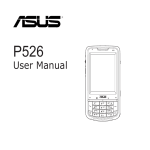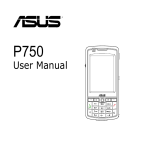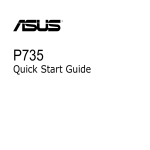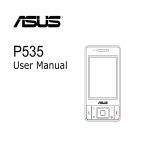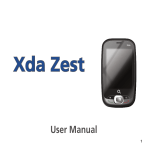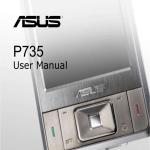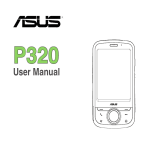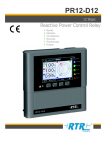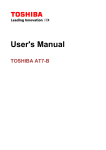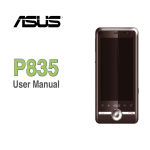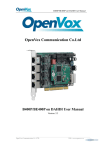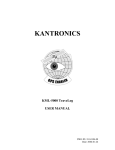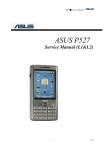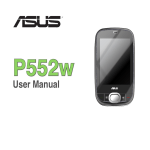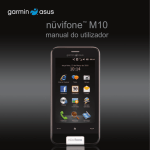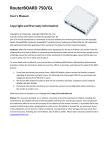Download User Manual
Transcript
P527 User Manual E3361 First Edition October 2007 Copyright © 2007 ASUSTeK Computers, Inc. All Rights Reserved. No part of this manual, including the products and software described in it, may be reproduced, transmitted, transcribed, stored in a retrieval system, or translated into any language in any form or by any means, except documentation kept by the purchaser for backup purposes, without the express written permission of ASUS Telecom (“ASUS”). Product warranty or service will not be extended if: (1) the product is repaired, modified or altered, unless such repair, modification of alteration is authorized in writing by ASUS; or (2) the serial number of the product is defaced or missing. ASUS PROVIDES THIS MANUAL “AS IS” WITHOUT WARRANTY OF ANY KIND, EITHER EXPRESS OR IMPLIED, INCLUDING BUT NOT LIMITED TO THE IMPLIED WARRANTIES OR CONDITIONS OF MERCHANTABILITY OR FITNESS FOR A PARTICULAR PURPOSE. IN NO EVENT SHALL ASUS, ITS DIRECTORS, OFFICERS, EMPLOYEES OR AGENTS BE LIABLE FOR ANY INDIRECT, SPECIAL, INCIDENTAL, OR CONSEQUENTIAL DAMAGES (INCLUDING DAMAGES FOR LOSS OF PROFITS, LOSS OF BUSINESS, LOSS OF USE OR DATA, INTERRUPTION OF BUSINESS AND THE LIKE), EVEN IF ASUS HAS BEEN ADVISED OF THE POSSIBILITY OF SUCH DAMAGES ARISING FROM ANY DEFECT OR ERROR IN THIS MANUAL OR PRODUCT. SPECIFICATIONS AND INFORMATION CONTAINED IN THIS MANUAL ARE FURNISHED FOR INFORMATIONAL USE ONLY, AND ARE SUBJECT TO CHANGE AT ANY TIME WITHOUT NOTICE, AND SHOULD NOT BE CONSTRUED AS A COMMITMENT BY ASUS. ASUS ASSUMES NO RESPONSIBILITY OR LIABILITY FOR ANY ERRORS OR INACCURACIES THAT MAY APPEAR IN THIS MANUAL, INCLUDING THE PRODUCTS AND SOFTWARE DESCRIBED IN IT. Products and corporate names appearing in this manual may or may not be registered trademarks or copyrights of their respective companies, and are used only for identification or explanation and to the owners’ benefit, without intent to infringe. Table of Contents P527 specifications................................................................................ 9 Package contents................................................................................. 10 Chapter 1: Getting started Getting to know your P527.................................................................. 12 Layout ...................................................................................................... 12 Device components description..................................................................... 14 Getting your device ready.................................................................... 16 Installing the SIM card and battery................................................................ 16 Charging the battery...................................................................................... 18 Starting up............................................................................................. 19 Powering your device..................................................................................... 19 Using the stylus.............................................................................................. 19 Calibrating P527............................................................................................ 20 Locking the keys and buttons........................................................................ 20 The Today screen................................................................................. 21 Status indicators............................................................................................ 22 Screen orientation.......................................................................................... 25 Start menu..................................................................................................... 26 ASUS Launcher..................................................................................... 27 Using the ASUS Launcher..................................................................................... 27 Chapter 2: Entering data Using the Input Panel........................................................................... 30 Using the Block Recognizer........................................................................... 30 Using the On-screen keyboard...................................................................... 31 Using the Letter Recognizer.......................................................................... 32 Using XT9 input............................................................................................. 33 Using the Transcriber..................................................................................... 34 Writing and drawing on the screen..................................................... 35 Recording voice.................................................................................... 36 Using ActiveSync™.............................................................................. 38 Synchronizing via mini-USB........................................................................... 40 Synchronizing with Exchange Server................................................. 41 Setting the synchronization schedule............................................................ 43 Searching information.......................................................................... 44 Getting Help.......................................................................................... 45 Chapter 3: Phone features Using phone.......................................................................................... 48 Phone pad...................................................................................................... 48 Adjusting the volume...................................................................................... 48 Making a call......................................................................................... 49 Using the alphanumeric keypad..................................................................... 49 Making calls from Contacts............................................................................ 51 Making calls from Call History........................................................................ 51 Using the Speed Dial..................................................................................... 52 Using Voice Commander............................................................................... 53 Receiving a call..................................................................................... 54 ASUS CallFilter..................................................................................... 55 Launching ASUS CallFilter............................................................................. 55 Using ASUS CallFilter.................................................................................... 57 Chapter 4: Wireless features Using the Wireless Manager................................................................ 62 Using Bluetooth®.................................................................................. 63 Overview ...................................................................................................... 63 Activating Bluetooth in your device................................................................ 63 Turning on WiFi.............................................................................................. 67 Configuring wireless networks....................................................................... 68 Adding a wireless network............................................................................. 69 Setting a GPRS connection................................................................. 71 Connecting GPRS.......................................................................................... 74 Disconnecting GPRS..................................................................................... 75 Using the GPRS Tool..................................................................................... 76 Chapter 5: GPS features GPS Catcher.......................................................................................... 78 Updating GPS data........................................................................................ 78 Setting GPS Catcher...................................................................................... 79 Travelog................................................................................................. 80 Turning GPS on............................................................................................. 80 Recording Travel Track.................................................................................. 81 Exporting Route............................................................................................. 84 Creating a New POI ...................................................................................... 87 Travelog Setting............................................................................................. 88 Location Courier................................................................................... 95 Using Location Courier.................................................................................. 95 External GPS......................................................................................... 98 Setting external GPS device.......................................................................... 98 Chapter 6: Multimedia features Using the camera................................................................................ 101 Launching the camera................................................................................. 101 Camera mode screen.................................................................................. 103 Taking photos................................................................................................110 Video mode screen.......................................................................................111 Recording videos..........................................................................................116 Viewing pictures and videos..............................................................117 Viewing pictures and videos..........................................................................117 Chapter 7: Business features Remote Presenter................................................................................119 Using the Remote Presenter.........................................................................119 Backup................................................................................................. 126 Backingup files............................................................................................. 126 Restoring files.............................................................................................. 128 Backup Setting............................................................................................. 130 Meeting Time Planner......................................................................... 131 Chapter 8: Special features NewStation.......................................................................................... 133 Reading NewStation news . ........................................................................ 133 Creating a new category ............................................................................. 133 Adding a new channel . ............................................................................... 134 NewStation Menus....................................................................................... 137 FM Radio.............................................................................................. 138 Listening to FM radio................................................................................... 138 Adding a new channel . ............................................................................... 138 Managing My Channel list............................................................................ 139 Configuring FM Settings.............................................................................. 140 Windows Live™.................................................................................. 141 Signing up.................................................................................................... 141 Setting ring tone................................................................................. 146 Adding ring tone to selection........................................................................ 146 Changing the ring tone................................................................................. 147 Wakeup setting................................................................................... 148 Mode switcher..................................................................................... 149 Restoring default factory settings.................................................... 152 Chapter 9: Device components status ASUS status icon................................................................................ 154 USB setting.................................................................................................. 155 LCD Brightness............................................................................................ 156 Battery .................................................................................................... 156 Memory .................................................................................................... 157 Storage card memory.................................................................................. 157 Programs Running in memory..................................................................... 158 Settings .................................................................................................... 158 Appendix Notices................................................................................................. 160 RF Exposure information (SAR)........................................................ 164 Safety information.............................................................................. 166 Contact information............................................................................ 174 P527 specifications Processor TI OMAP 850 Operating System Microsoft® Windows Mobile™ 6 Professional Memory 128 MB NAND Flash ROM 64 MB SDRAM Display 2.6-inch, 320 x 240 TFT Touchscreen Liquid Crystal Display (LCD) with 65,536 color and LED back-lighting Frequency band Quad-band GSM (850/900/1800/1900 MHz) Integrated GSM/GPRS/EDGE and GPS with internal antenna GPS Built-in SiRF star III chipset GPRS Class B, Multislot class 10 Camera 2.0 mega-pixel Auto Focus camera Connectivity Bluetooth USB WLAN Battery capacity 1300 mAh Lithium Ion Expansion slot MicroSD card slot Audio 2.5 mm audio port Built-in microphone and stereo output speaker Weight 129g (with battery) Dimension 113mm(L) x 58mm(W) x 15.4 mm(T) Talk time* 4 hrs (*vary with different networking environment and scenario) Standby time* 150 hrs (*vary with different networking environment and scenario) : V2.0+EDR : USB Client 1.1 : IEEE 802.11b+g NOTE: Specifications are subject to change without notice. Package contents Check your P527 package for the following items: P ASUS P527 device P Protection case P Battery P Getting Started CD P AC Adapter P User Manual P Mini-USB cable P Quick Start Guide P Headset P Warranty Card P Stylus P microSD* P Car cell phone charger* P Bonus CD* P Car Kit (PDA holder and windshield suction pedestal)* P Navigation CD & manual* *Optional, depends on the area NOTE: • The Protection case is only for protective usage and not a body-worn accessory. • If any of the above items is damaged or missing, contact your retailer. CAUTION: • To reduce risk of fire, use only correct battery type. Refer to “Installing the SIM card and battery” section for details. • Do not attempt to disassemble or service the battery pack. • Dispose of used batteries properly. Inquire from local authorities for proper disposal of battery. 10 Chapter Getting started 1 • Getting to know your P527 • Getting your device ready • Starting up • The Today screen 11 Getting to know your P527 Components: Layout 1 Power button 2 Jog dial 1 3 OK button I 4 Notification LED Top features 5 Earpiece receiver 6 LCD touch screen 5 4 7 Call Key 2 8 Left Soft key 3 9 Start button 10 Navigation Key 11 OK button 6 12 Right Soft Key 13 End Key 7 Left side features 12 8 9 10 11 12 13 14 16 19 15 18 20 21 22 17 Front features 14 Location courier key 15 Clear key 16 Travelog button 17 Alphanumeric keypad 18 Bluetooth Button 19 FM keypad 20 Message button 21 Mode switcher button 22 Voice Commander/Record button Components: 24 23 23 Camera lens 24 Stereo speaker 25 Battery compartment 26 Hold button 27 Reset button 26 28 Camera button 27 Reset 25 29 MicroSD slot 30 Stylus 31 Headphone slot 32 Mini-USB connector MicroSD 28 29 30 Right side features Rear features 32 31 Bottom features 13 Device components description No. 14 Item Description 1 Power button Press once to set suspend mode or to wake device from sleep mode. Press and hold to turn the power ON or OFF. 2 Jog dial This three-direction jog dial allows you to conveniently navigate through menus without necessarily using the stylus. 3 OK button Press to confirm a command or press to close/exit an open application. Press and hold to adjust the voice volume. 4 Notification LED This multi-color LED notifies the following: • Green - Phone fully charged. • Flashing green - Network detected. • Red - Phone is charging. • Flashing red - Event notification. • Flashing blue - Bluetooth® ,WiFi, or GPS is ON. 5 Earpiece receiver Allows you to listen to incoming/outgoing calls. 6 LCD touch screen This 2.6-inch, 65,536-color, 240 x 320-resolution, touchscreen TFT LCD allows you to write, draw, or make selections using the stylus. 7 Call key Press to receive an incoming call or to make a call. 8 Left Soft key Performs the command indicated above the button. 9 Start button Press to launch the Start menu. 10 Navigation key This five-direction navigation key allows you to navigate through menus. Press down to confirm a command. 11 OK button Press to confirm a command or press to close/exit an open application. 12 Right Soft key Performs the command indicated above the button. 13 End key Press to end a call or a GPRS connection. No. Item Description 14 Location courier key Long press to launch Location courier key. 15 Clear key Press to clear enter character to the left. 16 Travelog button Press to launch Travelog application. 17 Alphanumeric keypad Allows you to input text and numbers. 18 Bluetooth button Allows you to enable or disable Bluetooth feature. 19 FM keypad Press to launch FM radio application. 20 Message button Press to check Messages. 21 Mode Switcher button Allows you to switch applications. 22 Voice Commander/Record button Press to launch the Voice Commander application. Press and hold to launch voice recording. 23 Camera lens 2-mega pixel fixed lens for taking pictures. 24 Stereo speaker Allows you to listen audio media and phone calls. 25 Battery compartment Contains the battery that supplies power to the device. 26 Hold button Slide to enable or disable all keys including the LCD touch screen. 27 Reset button Using the stylus, press reset button to soft-reset your device. 28 Camera button Press and hold over three seconds to launch the camera. In camera mode, press to take a picture. In video mode, press to start recording video and press again to stop. 29 Micro-SD slot Insert a Micro-SD storage card into this slot. 30 Stylus Use the stylus to write, draw, or select items on the touch screen. 31 Earphone port Plug headset accessory to this port 32 Mini-USB connector Use this connector to synchronize your data or to charge the battery. 15 Getting your device ready Installing the SIM card and battery Before you can make a phone call using your P527, you need to install a Subscriber Identity Module (SIM) card. A SIM card contains your phone number, subscriber details, phonebook, and additional phone memory. Your P527 comes with a rechargeable Lithium-Ion battery. New batteries come partially discharged and should be fully charged before using them. They generally do not reach their rated capacity until they have been charged and discharged at least four (4) times. We recommend that new batteries be charged overnight even though they may indicate that the charge is complete after a few hours. Sometimes charging may stop during the initial charge and it is necessary to remove the battery for approximately fifteen (15) minutes and then put it back on charge. CAUTION: Use only an ASUS qualified battery. To install a SIM card and battery: 1. Remove the battery compartment cover. NOTE: When turned on, the device automatically turns off after you open the battery compartment to prevent data loss. 16 2. Remove the battery. 3. Insert the SIM card with its gold contacts facing down and the notched corner oriented to the upper right corner of the slot as shown. 4. Replace the battery into the compartment with its copper contacts properly aligned to the copper conductor on the device. 5. Replace battery compartment cover. 17 Charging the battery The bundled battery pack is shipped partially charged. Charge the battery up to four (4) hours before using for the first time. To charge battery: 1. Connect the AC adapter plug to the mini-USB connector at the bottom of the device. 2. Connect the AC power plug to a grounded wall socket or power strip. NOTE: • The notification LED turns red and charging battery icon appears on the status bar indicating that the battery is charging. • If your battery gets totally discharged, you need to recharge it for at least twenty minutes before you can turn it back on. 18 Starting up Powering your device Make sure that your P527 is fully-charged before starting the device for the first time. To turn power on: 1. Press and hold the power button. Power button 2. Follow onscreen instructions to align screen and set the local time zone. Using the stylus The stylus is a pen-like device found behind the bottom right corner of your P527. • Use the stylus to write, draw, select, or drag an item on the screen. • Single-tap an item to select it. • Tap and hold an item to see a menu. Stylus 19 Calibrating P527 Calibrating your device ensures that the item you tap on the screen is activated. This involves tapping in the center of targets that appear in various coordinates on the screen. To calibrate your screen: 1. Tap Start > Settings > System tab then tap Screen icon. 2. On the General tab tap Align Screen then follow succeeding calibration screen instructions. Locking the keys and buttons You can lock the keys and buttons of your device to avoid inadvertently dialing numbers or launching any application. To lock the keys and buttons: 1. Locate the Hold button on the right side of your device. 2. Slide the hold button downward to lock. Hold button 20 Reset 3. To unlock, slide the hold button upward. The Today screen The Today screen displays information useful to you. You can configure the Today screen to have all the important information you need. • To access the Today screen, tap Start > Today. • To personalize the Today screen, tap Start > Settings > Personal tab > Today. The following describes the common information found on the today screen: Status bar Tap to open the Start menu Tap to setup date, time, and alarm Tap to view connectivity status Tap to launch Wireless Manager Tap to set user information Indicates the battery status Tap to adjust volume Displays the signal status (The icon shows no SIM card and no signal When no SIM card is installed.) Displays the Bluetooth® /WiFi connection status Tap to open messages Tap to setup profile Tap to read or make appointments Tap to sign in Windows Live Tap to launch Live search engine Tap to setup tasks Tap to set Call Filter Tap to display device storage, USB setting, LCD brightness, battery, memory, and MicroSD status Tap to change screen orientation Tap to display ASUS Launcher Tap to launch Contacts list 21 Status indicators Refer to the table below for the Today screen icon status indicators. Icon Description General Packet Radio Services (GPRS) available. Connecting via GPRS. Connected via GPRS. Connecting with ActiveSync ActiveSync connection not active. ActiveSync synchronization in progress. Synchronization error. Call forwarded. Call in progress. Call on hold. Missed call. New Short Messaging Service (SMS) message. 22 Icon Description New voice mail. New Multimedia Messaging Service (MMS) message. No cellular phone service. No signal. Searching for cellular phone service. Indicates signal strength. Sound OFF. Sound ON. Battery low. Battery extremely low. Battery partially charged. Battery charging. 23 Icon Description Battery fully charged. Roaming service. This icon appears only if you have international roaming feature. Vibrate or Meeting mode on. Bluetooth headset connected. Bluetooth head connected with sound. Appears when you set the alarm No SIM installed. Notice indicator. Tap to view notice. 24 Screen orientation You can set the screen to two different orientations: 1. Portrait 2. Landscape Set to Portrait mode to get a better view or better operation of certain applications on your device. Set to Landscape when viewing pictures, video or viewing longer text files. To change the screen orientation, tap Start > Settings > System tab > Screen then select the orientation you want. You can also change the orientation by tapping the icon. Landscape mode Portrait mode 25 Start menu The Start menu contains various programs and applications that you commonly use. Tap Start to display the start menu items: Portrait mode Landscape mode You can also customize the items that appear in the Start menu. To do this: 1. Tap Start > Settings > Personal tab > Menus. 2. Select the check boxes of the items you want to appear in the Start menu. You can select up to seven (7) items. 26 ASUS Launcher ASUS Launcher is an alternative program that allows you to conveniently and quickly launch applications, perform tasks, and change device settings. You can run the Program from Start > Programs > ASUS Launcher, or tap ASUS Launcher at the lower left corner of the Today screen. Using the ASUS Launcher Tap to access messaging tools that allows you to write/read e-mail, MMS, or text messages. Tap to launch Internet Explorer, Messenger, and Windows Live. Tap to launch camera. Tap to launch File Explorer and view pictures/video, or search for files. Tap to launch applications. Tap to display the Contacts list. Tap to access MS Office, list tasks, set appointments, or jot notes. Tap to modify your device profile. You can also adjust the device audio and sound. Tap to launch games and applications menu. Tap to display your call history list. You can also make a call, send a message, delete call history, and check or reset call timer from this section. Tap to access submenus and modify the Audio, Personal, System, and Connection settings. You can also display your device information or restore the default settings of your device from this option. Tap to display items of GPS related applications. 27 28 Chapter Entering data 2 • Using the Input Panel • Writing and drawing on the screen • Recording voice • Using ActiveSync™ • Synchronizing with Exchange Server • Searching information • Getting Help 29 Using the Input Panel When you start an application or select a field that requires text, symbols, or numbers, the Input Panel icon appears on the menu bar. The Input Panel allows you to select various input methods including: XT9, Block Recognizer, Keyboard, Letter Recognizer, and Transcriber. Using the Block Recognizer The Block Recognizer allows you to use a single stroke to write letters, numbers, symbols, or punctuations, which are converted into typed text. To use the Block Recognizer: 1. In an application, tap the Input Panel arrow, then tap Block Recognizer. 2. Write letters, numbers, symbols, or punctuations in the designated writing area. • Write letters on the abc (left) area of the box. • Write numbers on the 123 (right) area of the box. • Tap the special symbols button to input symbols, punctuations and other special characters. • Tap Help “?” button for help on how to write characters. Tap for special characters Input panel 30 Using the On-screen keyboard With the on-screen keyboard, you can input text, symbols, numbers, or other special characters when input is possible. To input text using the on-screen keyboard: 1. In an application, tap the Input Panel arrow, then tap Keyboard. 2. Input text by tapping keys on the on-screen keyboard. Input panel To enlarge the on-screen keyboard: 1. Tap the Input Panel arrow, then tap Option. 2. Select Keyboard from the Input Method list. 3. Tap Large Keys. 31 Using the Letter Recognizer With the Letter Recognizer you can write individual letters, numbers, or special characters, which are converted into typed text. To use the Letter Recognizer: 1. In an application, tap the Input Panel arrow, then tap Letter Recognizer. 2. Write letters, numbers, symbols, or punctuations in the designated writing area. • Write capital letters on the ABC (left) area of the box. • Write lower case letters on the abc (middle) area of the box. • Write numbers on the 123 (right) area of the box. • Tap the special symbols button to input symbols, punctuations and other special characters. • Tap Help “?” button for help on how to write characters. Tap for special characters Input panel 32 Using XT9 input XT9 allows you to enter text in alpha-numeric format. As you key in alpha-numeric texts on the keypad, XT9 automatically matches your input with most likely the completed word. To switch to XT9 input, tap the Input Panel arrow, then tap XT9. XT9 input shortcuts • To key in a word or number, tap the keys on the keypad. • To insert a word or number from the word list: a. Use jog dial to move highlighted bar on word list. b. Press jog dial to add selected word or number. c. Press to delete previous character or highlighted text. Word list Tap to select a language. Press to delete character or selected text to the left Alpha-numeric keypad XT9 Settings To set XT9 according to your preference: 1. Tap Start > Programs > XT9 Settings. 2. Select your desired functions from the listed items: 3. Tap . 33 Using the Transcriber Transcriber is a handwriting recognition program that allows you to write in cursive, print, or mixed styles. It reliably recognizes not only written text but also numbers and symbols. Make sure to write legibly. See Help for more information on the Transcriber. To use the Transcriber: 1. Start an application that accepts user input, such as Notes or Word Mobile. 2. Tap the Input Panel arrow, then tap Transcriber. To write using Transcriber (using Notes): 1. Tap screen to position the cursor where you want the text to appear. 2. Use the stylus to write on the screen. The handwriting will be converted to text after you lift the stylus from the screen. To edit text: 1. Draw a line across the text you want to edit. After you lift the stylus from the screen, the line will disappear and the selected text will be highlighted. 2. You can now rewrite the text or use the Transcriber gestures to edit your selected text. See Help for the Transcriber gestures. Tap for Help 34 Input panel Writing and drawing on the screen You can write or draw directly on the screen and save notes in your own handwriting. If you prefer to use your own handwriting or use drawings in your notes, set the default input mode to Writing. If you prefer text, set the default mode to Typing. To set the default input mode for Notes: 1. Tap Start > Programs > Notes. 2. From the Notes list, tap Menu > Options. 3. In the Default mode: box, tap the down arrow and select any of the following: • Writing - if you want to draw or enter handwritten text in a note. • Typing - if you want to create a typed note. 4. Set the other options according to your preference. 5. Tap when finished. To write a note: 1. Tap Start > Programs > Notes. 2. From the Notes list, tap New. If you set the Default mode to Typing, a blank page appears for typed text. If you set the Default mode to Writing, a page with horizontal lines appears for handwritten text. You can also tap Menu and then select/deselect Draw option to switch between typing and writing mode. 3. Write/Draw on the screen. 4. When finished, tap to save the note and return to the Notes list. 35 Recording voice At any time, whether your phone is on stand-by or active mode, you can record sound, voice, or add a recording to a note while using your device. To create a voice recording: Press and hold the Voice Commander button to begin recording. Press and hold to launch voice recorder Or, you can do the following: 1. Tap Start > Programs > Notes. 2. From the Notes list, tap New. 3. If you do not see the recording toolbar, tap Menu > View Recording Toolbar. 4. Tap the record icon to begin recording. 5. Place the receiver near your mouth or source of sound. 6. Tap the stop icon when finished recording. A recording icon appears on the note. 7. Tap 36 . To add a recording to a saved note: 1. Tap Start > Programs > Notes. 2. From the Notes list, tap to open a saved note. 3. If you do not see the recording toolbar, tap Menu > View Recording Toolbar. 4. Tap the record icon to begin recording. 5. Place the receiver near your mouth or source of sound. 6. Tap the stop icon when finished recording. A recording icon appears on the note. 7. Tap . 37 Using ActiveSync™ ActiveSync™ allows you to synchronize data in your device with data in your computer. ActiveSync can also synchronize over a wireless or cellular network with Microsoft Exchange Server, provided that your cellular phone service or company is running Microsoft Exchange Server with Exchange ActiveSync. When synchronized directly with Exchange Server, you can stay up to date even when your PC is turned off. During synchronization, ActiveSync compares the data in your device with the data in your computer or Exchange Server, and updates all data with recent changes. You can select and synchronize data in the following locations using ActiveSync: • Contacts • Calendar • Email • Tasks • Notes • Favorites • Files • Media You can also exchange data between your computer and device without synchronizing. ActiveSync is already installed in your device, but before you can synchronize data with your computer, you must first install ActiveSync in your computer. Install ActiveSync from the Microsoft Getting Started CD that came with your device package. After you have installed ActiveSync, set up a sync relationship between your device and your computer. ActiveSync recognizes your device and automatically transfers the synchronization settings you have in your device. 38 If you wish to synchronize your device with Exchange Server through your company or service provider, obtain the name of the Exchange Server, user name, password, and domain name from your network administrator before starting the Sync Setup Wizard. To install and configure ActiveSync in your computer: 1. Insert the Microsoft Getting Started CD that came with your device package. 2. Follow succeeding screen instructions. 3. After the setup is complete, the Sync Setup Wizard automatically starts when you connect your device to your computer. Follow screen instructions to complete the wizard. 4. From the Sync Setup Wizard, you can: • Configure an Exchange Server connection to synchronize directly with an Exchange Server. Acquire from your network administrator the required parameters for input. • Create a synchronization relationship between your computer and your device. 5. Select the information type that you want to synchronize. 6. After you finish the wizard, ActiveSync automatically synchronizes your device. You can disconnect the device after the synchronization is complete. NOTE: • When connected, your device is automatically synchronized with your computer. ActiveSync synchronizes everytime you make a change on either the device or computer. • You cannot use WLAN to synchronize database. • Refer to your Windows® Mobile Help, for more information about ActiveSync synchronization. 39 Synchronizing via mini-USB You can connect to your device using the bundled mini-USB cable to synchronize to your computer. To synchronize your device via mini-USB: 1. After installing ActiveSync to your computer, connect the mini-USB plug to the mini-USB connector at the bottom of the device. 2. Connect the other end of the USB cable to your computer. Upon connection, ActiveSync automatically synchronizes your device. 40 Synchronizing with Exchange Server To synchronize your device with Exchange Server: 1. From the ActiveSync menu, tap Menu > Add Server Source. 2. In the Server Address field, input the name of the server running Exchange Server then tap Next. If necessary, tap the check box This server requires an encrypted (SSL) connection. 41 3. Input your name, password, and domain then tap Next. 4. Tap the check boxes to select the data items that you want to synchronize with Exchange Server. To change the available synchronization settings, select a data item then tap Settings. Tap Finish when done. 5. Start the sync process. 42 Setting the synchronization schedule To set the synchronization with Exchange Server: 1. From the ActiveSync screen, tap Menu > Schedule. 2. Refer to the table for input details. Volume Recommended setup High Select a shorter interval in the Peak times list. Low Select As items arrive option or a longer interval in the Off-peak times list. While roaming Sending messages Check Use above settings while roaming. Check Send/Receive when I click Send. 43 Searching information Using the search tool, you can search for files and other items stored in your device or the external MicroSD card. You can search by file name or by words located in various applications including the Calendar, Contacts, Excel Mobile, Word Mobile, Outlook Mobile, Help, Messaging, Notes, all data and Tasks. You can also filter your search to files larger than 64 KB. To search for a file or an item: 1. Tap Start > Programs > Search. 2. In Search for field, input the file name, word, or other information you want to search. 3. In Type field, select the data type to help you filter your search. 4. Tap Search. Found items are listed in Results. 5. In the Results list, tap the item with the information you need. 44 Getting Help You can easily find Help for using any program on the device. To get help for a program: • From the Today screen or program, tap Start > Help. A page will open with links to topics that explain how to use the program. 45 46 Chapter Phone features 3 • Using the phone • Making a call • Receiving a call • ASUS CallFilter 47 Using phone Like a standard cellular phone, you can use your P527 to make and receive calls. You can also keep a history of calls made and received, send SMS or MMS messages, take notes while talking, call from Contacts, and copy data from installed SIM card to your device. Phone pad The phone pad allows you to easily dial and access the Contacts, Call History, Speed Dial, and Phone settings. To launch the Phone pad, do any of the following: • Tap Start > Phone. • Press . Adjusting the volume To adjust the phone or device volume: 1. Tap from the status bar. 2. From the volume menu, you can: 48 •Move the slider to adjust device or phone volume. • Tap On, Vibrate, or Off to change the system and ringer volume settings. • Use the jog dial to adjust volume or set mode. Making a call You can make a phone call using the phone pad. You can also make calls directly from the Contacts, Call History, Speed Dial, or Voice Commander. Using the alphanumeric keypad To make a call using the alphanumeric keypad: 1. Ensure the device is not on hold. 2. Input the number of the party you want to call then press Call key. If you pressed the wrong number, press Clear key to erase number to the left. 3. Talk to the called party when connected. 4. When finished, press End key to end the call. Press to end call Press to clear input to the left Press to call dialled number Alphanumeric keypad 49 Phone pad features Displays the current call status Press to mute/unmute Press to launch Contacts list Press to turn speaker ON/OFF Press to take notes Press to launch keypad Using Smart dialer Smart Dialer utilizes the predefined alphabets or letters assigned to keys 2, 3, 4, 5, 6, 7, 8, and 9. Example: has letters a, b, and c. has d, e, f; and so on. Following the sequence of keys pressed, Smart Dialer displays items from your Contacts or previous calls containing the alphabets of the pressed key. 50 As shown in the example, keys 3, 4, and 2 were pressed, so all items beginning with the letter d, e, or f; items whose second letter is g, h, or i; and items whose third letter is a, b, or c are displayed. Press to hold /unhold call Press to end call Press to launch menu Making calls from Contacts To make a call directly from Contacts: 1. Press the Right Soft key or from the Today screen, tap Contacts. 2. You can do any of the following to make a call: • Tap name of contact, then from the Contacts screen, tap Call. • Tap name of contact, then press the Call key. • You can also tap and hold the contact, and from the shortcut menu tap Call Work, Call Home, or Call Mobile. • Tap Enter a name... then enter the name or number you want to call from Contacts. Press the Call key to dial the highlighted item. Making calls from Call History To make a call from the call history: 1. Tap Start > Phone. 2. On the Phone pad, tap the Call History button. 3. Scroll to the desired contact or phone number, then tap Call. To look for more numbers in other categories, tap Menu > Filter and tap a category. Call History button 51 Using the Speed Dial With Speed Dial you can call frequently dialled numbers in a single press. For example, if you assign a contact to the number 2 button in Speed Dial, press and hold to dial the contact’s number. To create a Speed Dial entry: 1. Make sure that the entry you want to create is already in the Contacts list. 2. Tap Start > Phone. 3. Tap the Speed Dial button on the Phone pad. 4. Tap Menu > New. 5. Tap a contact from the list then tap Select. 6. In the Location box, select an available key then tap OK. To delete a Speed Dial entry: • In the Speed Dial list, tap and hold an entry then tap Delete. 52 Using Voice Commander To make a phone call using voice commander: 1. Press the Voice Commander button. 2. From the following screen, your device asks you to “Say command.” 3. Audibly say “Call” then the name to call from your Contact list. 4. Say “Yes” or “No” after the confirmation question. If you said “Yes”, the application proceeds and dials the number; otherwise, it returns to the Voice Commander menu. 5. Say “Goodbye” or tap Commander. to exit Voice Press to launch Voice Commander NOTES: To use Voice Commander while using a headset, press the answer button* on the headset then follow given instructions. (* Answer button may not be available in some headset models.) 53 Receiving a call When you receive a call, a message prompts and allows you to answer or reject the incoming call. To answer or reject an incoming call: • To answer a call tap Answer, or press Call key. • To reject an incoming call, tap Ignore, or press End key. TIP: Press and hold Call key to switch receiver to speakerphone mode. Call key The following pop-up screen appears during an incoming call: • Tap Answer to receive call or • Tap Ignore to dismiss call. To terminate a call: • Tap End or press End key to terminate an incoming or outgoing call. 54 End key ASUS CallFilter The ASUS CallFilter is a simple yet efficient utility that allows you to control all your incoming calls. Using this utility, you can manage a list of telephone numbers from your Contacts list, Call logs, Message number, or any unlisted telephone number that you want to accept or reject. Launching ASUS CallFilter Tap from the Today screen to launch the ASUS CallFilter. Tap to launch CallFilter 55 The first time you launch ASUS CallFilter, you need to install and select the storage location for ASUS CallFilter. The following describes the steps when running ASUS CallFilter the first time. 1. After tapping , from the Today screen, the utility installs the necessary cabinet (.cab) files to your device. Follow succeeding screen instructions to complete the process. IMPORTANT: The installation may take a few seconds to complete. DO NOT turn off your device during the installation process. 56 2. When prompted, select storage location then tap Install. 3. When finished, tap Ok to restart your device. Using ASUS CallFilter After installing the necessary files, tap to launch the ASUS CallFilter shortcut menu. The shortcut menu allows you to conveniently activate either the Accept or Reject list. From the shortcut menu, do any of the following: • Tap Accept List to activate Accept list and receive only incoming calls whose numbers are in the Accept list. • Tap Reject List to activate Reject list and reject all incoming calls whose numbers are in the Reject list. • Tap Edit to open the CallFilter utility screen. • Tap Close to deactivate CallFilter. CallFilter shortcut menu 57 Managing the Accept list The Accept list allows you to select telephone numbers you only want to accept. Incoming calls that are not in the Accept list will automatically be rejected. To add items in the Accept list: 1. From the ASUS CallFilter shortcut menu, select Edit. 2. Select Accept List from Edit List box. 3. Select source of data. You can get data from your Contacts, Call logs, Message number, and you can select any anonymous or key in a new number. 2 3 4. From the list (e.g. Contacts), select an item then tap Add. You can also tap Accept list item. 5. Click to add a new to exit. To remove items from the Accept list, select a contact from the Accept list then tap Remove or . 4 58 Managing the Reject list The Reject list allows you to select telephone numbers you want to reject. Incoming calls that are in the Reject list will be rejected. To add items in the Reject list: 1. From the ASUS CallFilter shortcut menu, select Edit. 2. Select Reject List from Edit List box. 3. Select source of data. You can get data from your Contacts, Call logs, Message number, and you can select any anonymous or key in a new number. 2 3 4. From the list (e.g. Contacts), select an item then tap Add. You can also tap Reject list item. 5. Click to add a new to exit. To remove items from the Reject list, select a contact from the Reject list then tap Remove or . 4 59 60 Chapter Wireless features 4 • Using the Wireless Manager • Using Bluetooth® • Using Wi-Fi • Setting a GPRS connection 61 Using the Wireless Manager The Wireless Manager allows you to enable or disable your wireless connections in a single location. This is a quick way to preserve battery power or to prepare your device for an airplane flight. To use the Wireless Manager: 1. Tap Start > Settings > Connections tab. 2. Tap Wireless Manager. 3. From the Wireless Manager screen, do any of the following: •Tap the button for a desired wireless connection type to turn it on or off. •Tap •Tap Menu to change settings for one of the displayed wireless connection types. to turn off all wireless connections. Tap to turn off all wireless connections Tap to turn Wi-Fi connection on or off Tap to turn Bluetooth® connection on or off Tap to turn Phone connection on or off Tap to exit Wireless Manager 4. Tap Exit or 62 to exit Wireless Manager. Tap to disconnect cellular data or change settings Using Bluetooth® Overview Bluetooth® is a short-range wireless communications technology that allows devices with Bluetooth capabilities to exchange data within a radius of about 10 meters (30 feet) without requring a physical connection. With Bluetooth enabled in your device, you can: • Connect and communicate (i.e. beam files, tasks, contacts) with other devices with Bluetooth features. • Use Bluetooth service. After you connect to another device or computer using Bluetooth, you can use the services available on that device. Activating Bluetooth in your device Use the Wireless Manager to enable or disable Bluetooth in your device. You can access the Wireless Manager by performing any of the following: 1. Launch the Wireless Manager. To do this, you can either: • Tap Start > Settings > Connections tab > Wireless Manager. • Tap the Wireless Manager icon from the Today screen. 2. From the Wireless Manager screen, tap Bluetooth. Tap to launch Wireless Manager NOTES: When not in use, deactivate Bluetooth in your device to conserve battery power. 63 Adding Bluetooth devices 1. Ensure that Bluetooth is enabled on the device you want to add and the device is set as Discoverable. 2. Tap Start > Settings > Connections then tap Bluetooth icon. 3. Tap Add new device... to search for available Bluetooth devices. The search may take a while. 4. Select the device you want to connect with then tap Next or press the Right Soft key. 64 5. Enter the alphanumeric passcode of the device you want to connect then tap Next or press the Right Soft key. You can find the passcode in the documentation that came with the other device. 6. Enter the display name for this connection. 65 7. Repeat steps 3 - 6 to connect more devices. 66 Using Wi-Fi® Wi-Fi provides the very best connection available for computer networking and home entertainment applications alike - delivering the range, bandwith, and performance that today’s multimedia applications and products demand. Turning on Wi-Fi Use the Wireless Manager to enable or disable Wi-Fi in your device. You can access the Wireless Manager by performing any of the following: 1. Launch the Wireless Manager. To do this, you can either: • Tap Start > Settings > Connections tab > Wireless Manager. • Tap the Wireless Manager icon from the Today screen. 2. From the Wireless Manager screen, tap Wi-Fi. Tap to launch Wireless Manager 67 Configuring wireless networks To configure a wireless network, you need to launch the Wi-Fi settings page: 1. To launch the Wi-Fi settings page, you can either: • Tap Settings after selecting a wireless network to connect your device to. • Tap Start > Settings > Connections tab > Wi-Fi. 2. From the Configure Wireless Networks screen, tap an available wireless network, then make the necessary changes. If the wireless network you want is not on the list, tap Add New.... 3 Tap the Network Adapters tab and select an adapter. Tap an adapter to set it if necessary. 4. Tap 68 when done. Adding a wireless network If the device fails to automatically detect the wireless network you want to connect to, you can add the network. Ask for the wireless network settings from your network administrator. To add a wireless network, you need to launch the Wi-Fi settings page: 1. To launch the Wi-Fi settings page, you can either: • Tap Settings after selecting a wireless network to connect your device to. • Tap Start > Settings > Connections tab > Wi-Fi. 2. Tap Wireless > Add New.... 3. Enter a name for the network and select an item from the Connects to: drop-down menu, then tap Next. 69 4. Set authentication, data encryption, and network key. Ask your network administrator for these information, then tap Next. 5. If you need to change the EAP type, check the adapter box, then change the EAP type. 6. Tap Finish when done. 70 Setting a GPRS connection Your P527 allows you to connect via General Packet Radio Service (GPRS). GPRS is a wireless communication standard that runs at speeds of up to 115 kbps, compared to 9.6 kbps of the current Global System for Mobile Communications (GSM). It supports a wide range of bandwidths that allows sending and receiving small bursts of data, such as email and web browsing. To set a GPRS connection in your device: 1. From the Today screen, tap status bar. on the 2. Tap Settings on the message prompt. Pop-up callout 3. From the Settings screen, select the Connections tab then tap Connections icon. 71 4. From the Connections screen, tap Add a new modem connection. 5. Input a unique name for the connection then select Cellular Line (GPRS) from the modem list. 72 6. Input the Access point name. 7. Input your user name, password, and domain then tap Finish. Contact your network administrator for assistance. NOTE: The GPRS and USB connections can not be used at the same time. 73 Connecting GPRS To connect GPRS: 1. Tap Start > Settings > Connections tab then tap Connections icon. 2. From the Connections screen, tap Manage existing connections. 3. Tap and hold on an existing connection then from the pop-up menu tap Connect. Tap Delete if you want to delete selected connection setting. 4. When connected, tap to exit. NOTE: • When WLAN is used simultaneously with the GPRS, the latter will get signal priority. We recommend not to use WLAN and GPRS at the same time. 74 If you have set a default GPRS connection, it automatically connects when you launch an application that connects to the Internet. 1. Launch any application that connects to the Internet (e.g. Internet Explorer). The device will automatically connect your default GPRS connection. A pop-up callout appears to display the connection status. Pop-up callout 2. When connected, you can start browsing the Internet. If you are using Internet Explorer, the default site will be displayed. Disconnecting GPRS To disconnect GPRS: 1. Tap from the status bar. 2. From the pop-up callout, tap Disconnect. NOTE: • If your ActiveSync is set to sync with Exchange Server automatically, synchronization will occur after you connect again. • GPRS will automatically reconnect everytime you launch an application that requires GPRS connection (e.g., Internet Explorer or Pocket MSN). 75 Using the GPRS Tool The GPRS Tool allows you to conveniently select and connect to your GPRS service provider. To connect via GPRS Tool: 1. Tap Start > Settings > Connections tab then tap the Network Setting icon. You can also tap on the status bar then tap Settings from the pop-up callout. 2. From the Network Setting screen, select your GPRS provider from the list. NOTE: • Operators vary in different regions. • The GPRS and USB connections cannot be used at the same time. 76 Chapter GPS features 5 • GPS Catcher • Travelog • Location Courier • External GPS 77 GPS Catcher The GPS Catcher allows you to download the GPS data so that the GPS data in your device is up-to-date. The GPS data contains important information about the status of satellite, current date and time for determining the satellite position. Updating GPS data To update GPS data: 1. Tap Start > Programs > GPS Catcher. 2. Connect your device to PC with the USB cable, then tap Update to start updating. NOTE: To make a successful update, make sure ActiveSync 4.5 is installed in your PC and your PC is connected to the Internet. 78 3. Tap when finished. NOTE: The expiration of GPS data is three days. You need to update it when it is expired. You can also set GPS Catcher to update automatically, refer to the following section Setting GPS Catcher. Setting GPS Catcher To set GPS Catcher: 1. From the GPS Catcher screen, tap Menu > Setting. 2. Check the options at your preference. when finished. Tap 79 Travelog Travelog allows you to record your travel track and export the data to Google Earth placemark files (kmz) Turning GPS on To turn GPS on: 1. Tap Start > Programs > Travelog > Menu. 1. Physical distance 2 1 2. Scale 3. Zoom in button 4. Zoom out button 1 3 5. Current time 4 6. Status bar 6 5 2. Tap Turn On GPS to start searching for GPS signal. 80 Record button Pause button Recording Travel Track To record travel track: 1. Tap Start > Programs > Travelog > Menu > New Route. Enter a name for the route. If you want to record the check point, check the Record Check Point box and set an interval. Refer to GPS setting in Travelog Setting section for details about setting GPS and power saving. 2. Tap Start to begin recording your travel track. When GPS signal is received, tap the Record button to start recording the track. Tap Pause/Resume to pause or resume recording. Waiting for GPS signal Recording 81 While recording, you can view related information from the Status bar. • When the Status bar shows (current GPS position in Longitude/Latitude format), tap the bar to display the GPS Status screen. • When the Status bar shows elapsed), tap the bar to display the Speed screen. (trip distance and the time • When the Status bar shows tap the bar to display the Compass. (speed, elevation and direction), • When the Status bar shows (the number of Point of Interest - POI and check point), tap the bar to display the GPS Status screen. Tap to display Compass Tap to Zoom in Tap to pause or resume recording Tap to Zoom out Tap to view status Tap to display the menu 82 3. Tap Menu > Stop to stop recording. The tracking records are saved in My Favorite. •New POI: Tap to create a new POI. Refer to the following section Creating a New POI for details. •My Favorite: Managing all the trip and POI data. This function is disabled while recording a trip. •Pause: Tap to suspend recording a trip. GPS is still on in this mode. •Stop: Tap to stop recording a trip and turn GPS off. 83 Exporting Route You can export your trip route to Google Earth placemark files (kmz). To export a route: To export a route: 1. From the Track screen, tap Menu > My Favorite. 2. From the route list, select a route and tap Export button. 3. Edit the route name and select the destination folder and storage place, then tap Next. You can also set export settings. Refer to the Export Setting item in the Travelog Setting section for details. 84 4. When exporting, you can tap Cancel to stop exporting. 5. When finished, tap notification. on the pop-up The display modes of routes on Google Earth vary from the output mode and enhanced presentation mode you set in Export Setting. See the examples on the next page. 85 Normal Mode Speed Mode with 2-D Presentation Speed Mode with 3-D Presentation 86 Creating a New POI While recording track, you can create a new Point of Interest (POI) in current position. To create a new POI: 1. From the Track screen, tap Menu > New POI. 2. In the Info tab, you can edit the name of the POI, change the icon, and add up to three pictures for the POI. 3. In the Content tab, you can add description to the POI. You can also change the text font and color in the Advanced Edit. 4. Tap when finished. NOTE: The New POI function is disabled when GPS is off. 87 Travelog Setting GPS Setting GPS Setting allows you to set GPS mode and power saving mode while using GPS. To set GPS and power saving: 1. From Track screen, tap Menu > Setting > GPS Setting. 2. Current GPS setting is showed. You can tap GPS Hardware Setting to change the settings. NOTE: Refer to the section External GPS for details. 3. Tap Power Saving Setting. Check the options and set values at your preference. 4. Tap 88 when finished. System Setting System Setting allows you to set the unit display style, backlight, and speed limit warning. To set up the system setting: 1. From Track screen, tap Menu > Setting > System Setting. 3. Tap 2. Set the unit display style, backlight mode, and speed limit. when finished. 89 Export Setting Export Setting includes Point Setting and Mode Setting. • Point Setting Point Setting allows you to change name and icon of start/end point, check point (milestone point), and POI point. You can also set marking-information label for the points. To do Point Setting: 1. From the Track screen, tap Menu > Setting > Export Setting > Point Setting. 2. Tap the tabs of points at the bottom of the screen to set each point. Tap Change to change an icon. 3. Tap 90 when finished. • Mode Setting Mode Setting allows you to set the presentation features of exported data, such as digit range, line color and size. You can also set the size and display effect of exported data. To do Mode Setting: 1. From Track screen, tap Menu > Setting > Export Setting > Mode Setting 2. Tap the name of mode to launch detailed mode setting. 3. Choose color and size for line. 4. Tap when finished. 91 Hotkey Setting This function allows you to assign hotkeys and apply functions conveniently while running Travelog. To assign hotkeys: 1. From the Track screen, tap Menu > Setting > Hotkey Setting. 2. Tap when the tips pop up. If you do not want it show next time, check the Don’t show tips box. 92 3. From the drop-down menu, choose functions that you want to assign to the keys. Tap Next to continue. 4. From the drop-down menu, choose functions that you want to assign to the keys. Tap when finished. You can also tap Reset button to restore the settings to default. Keys Description Left key Push the navigation key leftward. Right key Push the navigation key rightward. Up key Push the navigation key upward. Down key Push the navigation key downward. Center key Press the navigation key down. 93 Reset All This function allows you to reset Travelog to its default settings to fix and recover database. To reset settings and recovery database : 1. From the Setting dialog, tap Reset All button. 2. Tap Repair button to fix and recover the database. Tap Reset All button to reset all settings to default, then tap Yes from the pop-up window to confirm. Check the Erase the database box if you want to clear all the database. About You can view version and copyright information of the Travelog application. To view Travelog version and copyright: From the Track screen, tap Menu > Setting > About. 94 Location Courier The Location Courier allows you to send your position through SMS messages to up to five receivers at the same time. You can also set a timer to send SMS messages periodically. Using Location Courier To use Location Courier: 1. Tap Start > Programs > Location Courier. 2. Tap Menu > Setting to edit message content and set Location Courier properties. NOTE: The GPS automatically turns on when you launch Location Courier application. 95 96 3. Enter the number of the recipient then tap Add to add it to the Contacts list. 4. Tap Contents tab then enter message. 5. Tap Options tab then check your desired properties. 6. Tap SMS Sending Rule tab then select time interval and check your desired to finish setting. properties. Tap 7. The message and receivers you set appear on the Location Courier screen. Tap Start to get and send the location information through SMS. You can also turn on/off GPS or exit the Location Courier application from Menu. Receivers list Message content Stop button GPS status Location Courier status Tap to display menu A message prompts to notify you when your SMS message has been sent successfully. While running Location Courier, you can view GPS status from the task bar of Today screen. You can tap the status icon to open Location Courier screen. Active (Red) Waiting (Lime) DeActive (Gray) 97 External GPS P527 allows you to use an external GPS device to receive GPS data. To use an external device, you need to set connection between P527 and your external GPS device. Setting external GPS device To set an external GPS device: 1. Tap Start > Settings > System tab > External GPS. 2. From the Programs tab, select a program port. NOTE: The other GPS application in P527 will use the same COM Port as you set here. Ensure that this port is also available in the other GPS applications. 98 3. From the Hardware tab, specify a hardware port and baud rate for your external GPS device to use. Refer to the user guide of your external GPS device for details. 4. From the Access tab, check the Manage GPS automatically (recommended) check box. NOTE: If you clear this check box, some GPS related application in P527 may not be able to obtain GPS data. 99 Chapter Multimedia features • Using the camera • Viewing pictures and videos 100 6 Using the camera The built-in two-megapixel camera allows you to take photos and record audio/video clips. Launching the camera To start using the camera: • Tap Start > Programs > Pictures and Videos > Camera icon or • Press and hold the Camera button on the right side of your device. Reset Camera/shutter button MicroSD Camera button NOTE: • By default, the preview screen is set to landscape. • After launching the camera, your device is set to camera mode by default. • In camera mode, the camera button function as shutter button. To exit the Camera: • Tap the exit icon on the camera screen. 101 Available capture modes Your device camera can be set to two capture modes: • Camera mode - Camera mode allows you to take photos, and save them to your device or MicroSD. You can also configure the camera to match an environment, set picture size, select magnification, adjust the picture quality, apply effects, and modify other advanced settings. • Video mode - Video mode enables you to record audio/video clips. Like in camera mode, it also allows you to select the magnification, set the video size, apply some effects, select target storage, and modify advanced video settings. Supported formats Using the camera mode or video mode, the images or video clip captured are stored in the following formats: • Still image (Camera mode) - JPEG (.jpg) • Video (Video mode) - 3GP (.3gp), MPEG-4 (.mp4) 102 Camera mode screen The following describes the screen icons in Camera mode: Capture mode icon Picture quality icon Default storage icon Scene mode icon Timer icon Burst mode icon Effects icon Picture Size Tap to close camera Number of available shots Tap to launch camera menu Capture modes: Camera mode Video mode Tap to zoom out Tap to zoom in Tap to preview Pictures and Videos 103 Camera mode icons • Capture mode icon [ / ] - indicates the current capture mode. • Picture quality icon [ / / • Default storage icon [ videos clips. • Scene mode icon [ / ]- indicates the picture quality used. / ] - indicates default storage for captured images and / ] - indicates the scene mode used. / ] - when the camera timer is enabled (5 seconds or 10 seconds), the • Timer icon [ corresponding timer icon appears. When you press the shutter button or the navigation button to take a picture, the count down begins and picture is taken after the time set. • Burst mode icon [ / • Effects icon [ / / ] - indicates the number of frames in burst mode. / ] - indicates the effects used. • Picture Size [ / / / / / ] - shows the resolution used. When set to 1600x1200 resolution, the zoom in/zoom out function is disabled. • Exit icon [ ] - tap to exit camera. • Zoom In [ ] - tap to zoom in view of subject on screen. • Zoom Out [ ] - tap to zoom out view of subject on screen. • Thumbnails [ your images in thumbnails. • Menu [ ]- tap to launch Pictures and Video application and preview ] - tap to launch camera menu options. • Remaining shots information - shows the remaining, available shots of pictures based on the current settings. 104 Camera options menu The camera options menu allows you to change various camera and picture settings. To launch options menu: 1. Tap Menu from the camera screen. 2. From the shortcut menu, tap an icon to display contents. Camera options shortcut menu 105 Change Mode The Change Mode option allows you to set capture mode into Camera or Video mode. Scene The Scene option allows you to select presets appropriate for a night scene or sports event. Select Auto to use best setting for any scene. Picture Size Allows you to set the frame size of picture. 106 Picture Quality This option provides three picture quality presets: Normal, Fine, and Super Fine. The picture quality is set to Super Fine by default. Zoom Allows you to change the maximum magnification allowed. Self-Timer Sets the delay of shutter release to 5 or 10 seconds after you have pressed the camera/shutter button. 107 Burst Allows you to take 4 or 9 pictures in succession with one press of the camera/ shutter button. Frame Allows you to set a frame. NOTE: Ensure that you have set the screen resolution to 320 x 240 before setting frame. Effect The Effect option allows you to apply some effects to the subject. Select from the following configuration options: Black-White, Negative, Solarize, and Sepia. Set to Normal for no effect. 108 Save to Allows you to select the default storage for captured pictures. NOTE: Prepare a MicroSD card before setting default storage to Storage Card. Advanced This option allows you to set the following: - Filename prefix format - Filename prefix - File number - Date and time stamp - Shutter sound - Burst interval 109 Taking photos After launching the camera, your device is set to Camera mode by default. If set otherwise, tap Menu > Change Mode > Camera Mode then tap Exit. You can also set to camera mode by tapping the camera mode icon on the screen. To take a photo: 1. Aim device to your subject then press camera/shutter button. icon appears, make sure 2. When the the device is stable and not shaking. 3. Repeat steps 1 to 2 to take more photos. NOTE: The image is automatically saved to the default storage location and can be viewed using the Pictures and Videos application. 110 Video mode screen The following describes the screen icons in Video mode: Capture mode icon Remaining video recording time Default storage icon Effects icon Video Size Tap to close camera Recording indicator Green: Ready Red: Recording Tap to launch video menu Capture mode icons: Camera mode Video mode Tap to zoom out Tap to zoom in Tap to launch Pictures and Videos 111 Video mode icons • Capture mode icon [ / ] - indicates the current capture mode. • Default storage icon [ / ] - indicates default storage for captured video clips. • Effects icon [ / ] - indicates the effects used. • Video size [ / / / ] - shows the video size used. • Exit icon [ ] - tap to exit video. • Zoom In [ ] - tap to zoom in view of subject on screen. • Zoom Out [ • Thumbnails [ your video. • Menu [ ] - tap to zoom out view of subject on screen. ]- tap to launch Pictures and Video application and play ] - tap to launch video menu options. • Remaining video recording time information - shows the remaining, video recording time based on the current settings. 112 Video options menu The video options menu allows you to change various video and playback settings. To launch video options menu: 1. Tap Menu from the video screen. 2. From the shortcut menu, tap an icon to display contents. Video options shortcut menu 113 Change Mode The Change Mode option allows you to set your device into Camera or Video capture mode. Zoom Allows you to change the maximum magnification allowed. Video Size Allows you to set the frame size of video. 114 Save to Allows you to select the default storage location for captured pictures. NOTE: Prepare a MicroSD card before setting default storage to Storage Card. Effect The Effect option allows you to apply some effects to the subject. Select from the following configuration options: Black-White, Negative, Solarize, and Sepia. Set to Normal for no effect. Advanced This option allows you to set the following: - Video file type - Filename prefix format - Filename prefix - File number - Enable or disable audio when recording 115 Recording videos Set the device to video capture mode to record videos. To set video mode: • Tap Menu > Change Mode > Video Mode then tap Exit. • You can also set the video mode by tapping the video mode icon on the screen. To record video: 1. Aim device to your subject then press camera/shutter button to begin recording. The record indicator turns from green to red while video is recording. 2. Press the camera/shutter button again to stop recording. 116 NOTE: •The video clip is automatically saved to the default storage location. •Use Windows Media Player Mobile to playback video clip in your device. • Use Apple® QuickTime™ player, if you wish to play video clips in your computer. You can download QuickTime™ installer from www.apple.com/quicktime. Viewing pictures and videos Use the Pictures and Video Application to preview stored images and playback video clips. Viewing pictures and videos To view pictures and videos: 1. Tap Start > Programs > Pictures and Videos. 2. Tap the picture or video clip you want to see. • To view pictures or launch video clips stored in MicroSD card, tap the folder list (labeled My Pictures), and tap MicroSD Card. • To view pictures stored in My Pictures folder on your device, tap My Pictures then tap picture thumbnail. • To playback video clips in My Videos folder on your device, tap My Videos then tap video thumbnail. 117 Chapter Business features • Remote Presenter • Backup • Meeting Time Planer 118 7 Remote Presenter From your P527 device, Remote Presenter allows you to remotely control PowerPoint™ presentations running on your desktop or notebook. Operating over a Bluetooth wireless connection, it promotes convenience and freedom of movement during your presentation. It also enables you to review slide notes without affecting the audience’s view of the slide show. Using the Remote Presenter IMPORTANT: • Before you start, make sure to install the Remote Presenter utility on your computer. You can find the installation files in the bundled support CD. •Remote Presenter works with Bluetooth-enabled computers only. •The screen captures in the following setup are for reference only and the sequence may appear differently, depending on the previous Bluetooth configuration performed on your system. To use the Remote Presenter: 1. Tap Start > Programs > Remote Presenter. You can also execute Remote Presenter from the ASUS Launcher menu. From the ASUS Launcher menu, tap Application then tap Remote Presenter. 2. Do the following before searching for Bluetooth devices: •Activate Bluetooth in your computer. •Launch the Remote Presenter program in your computer. To do this, from your computer desktop, click Start > All Programs > ASUS > Remote Presenter. When ready, tap Next on your device. 119 The following describes the Remote Presenter menu on your computer screen. PowerPoint .ppt file path Click to change path Click to start or stop Bluetooth COM port Click to exit 4. Check your computer screen when your P527 prompts the following message: 3. From the list of Bluetooth devices found, select the name of computer containing your PowerPoint presentation then tap Next. 5. The following message appears on your computer screen. Click the message prompt to allow your P527 to access the ActiveSync service of your computer. 120 6. Tap Yes to allow your computer to connect to your device. 7. From your computer, key in an authentication passkey then click OK. The authentication passkey is used to secure your connection. 8. When prompted, input the same authentication passkey on your P527. NOTE: The Bluetooth authentication passkey is only required if a paired relationship is not yet established between devices. 121 9. Tap the check boxes to select services for your device then click Finish. 11.From the Remote Presenter menu on your computer, click to establish a connection. 122 When prompted with the Bluetooth Service Authorization message, click OK. 10.Tap Connect to connect to your computer. 12.The following screen appears on your device when a successful connection was established. 13.Tap the name of PowerPoint (.ppt) file to show then tap Select. Repeat from step 1 if the connection failed. 123 124 Upon selection, Microsoft® PowerPoint is automatically launched on your computer with the selected file open. 14.You can now remotely control the PowerPoint presentation on your computer using your device. The following describes the control menu on your device. Slide number Tap to exit Tap to select slide Indicates Bluetooth® signal Timer Tap to toggle between Normal and Slide Show view Previous slide Tap to display notes Next slide Tap to display menu options Tap to return to control panel 125 Backup Backup allows you to backup or restore your files and data to your device or storage card. Backing-up files To backup files: 1. From the Today screen, tap Start > Programs > Backup > Backup. 126 2. Select the items you want to backup, then tap Next. 3. Rename the file and select the storage location for the backup, then tap Next. 4. Enter four digits as your password to encrypt the backup file, then tap Next. 5. Tap Start to begin backup. Tap Back to return to the previous screen. 6. Tap Reset to reset the device. NOTE: The system will turn off all processing applications when backing up files. 127 Restoring files To restore files 128 1. From the Today screen, tap Start > Programs > Backup > Restore. 2. Select a file you want to restore, then tap Next. 3. Input four-digit password to decrypt the backup file, then tap Next. 4. Select the items you want to restore, then tap Next. 5. Tap Start to begin restore, or tap Back to return to the last screen. 6. Tap Reset to reset the device. NOTE: The system will turn off all processing applications when restoring files. 129 Backup Setting To set Backup 1. From the Today screen, tap Start > Programs > Backup, then tap Option. 130 2. Check the box if you want to reset the to finish. device after backup, then Tap Meeting Time Planner Meeting Time Planner allows you to find a suitable time to have a video conference, telephone or net meeting with participants in different time zones. Using the Meeting Time Planner To use the Meeting Time Planner: 1. Tap Start > Programs > Meeting Time Planner. 2. Select the date and the cities. A color-coded 24-hour time table of the chosen cities appear, allowing you to identify the best time for the meeting. Dark blue is late night/early morning, light blue is off-peak hour, and white is peak daytime hour. You can also change the interval of time shown by tapping Interval on the lower-right corner of the screen. 3. Select the time for your meeting and tap New Date. 4. Fill in the meeting information and tap OK to add your date into the Calendar. NOTE: You can tap Interval > Summer Time use daylight saving time. 131 Chapter Special features • NewStation • FM Radio • Windows Live™ • Setting ring tone • Wake-up setting • Mode switcher • System information • Restoring factory default settings 132 8 NewStation With NewStation in P527, you can conveniently browse news and blogs anywhere and anytime. NOTE: Ensure your device is connected to Internet when using NewStation. Reading NewStation news To read NewStation news: 1. Tap Start > Programs > NewStation. 2. Tap a category folder to open. 3. Tap a channel name to open. 4. Browse your favorite subjects. Creating a new category To create a new category folder: 1. Tap Start > Programs > NewStation. 2. Tap Menu > New Category then edit the category name. 133 Adding a new channel Before using this function, you need to add your favorite channels first. To add a channel: 1. Tap Start > Programs > NewStation, then tap a category folder to open. 2. Tap Menu > New Channel. You can add a channel from either Internet or an existing file. 134 Input from URL Select Input from URL and enter the URL address, then tap Next. Select a category where you want to add the channel, then tap Finish. Import from a file Select the radio button of Import from a file, then tap Next. Select a folder and choose a file from the list. 135 136 Choose channels from the list, then tap Next. Select a category where you want to add the channel, then tap Finish. NewStation Menus Category Menu To use the category menu: 1. Tap Start > Programs > NewStation. 2. Select a category folder, then tap Menu. 3. Tap an option as desired. Channel Menu To use the channel menu: 1. Tap Start > Programs > NewStation. 2. Tap a category folder, then select a channel and tap Menu. 3. Tap an option as desired. Subject Menu To use the subject menu: 1. Tap Start > Programs > NewStation. 2. Tap a category folder, then tap a channel to open. Select a subject and tap Menu. 3. Tap an option as desired. 137 FM Radio From your P527 device, FM Radio allows you to listen to FM radio anywhere and anytime. Listening to FM radio To listen to FM radio. 1. Tap Start > Programs > FM Radio. 2. Tap Menu > Turn On/Off to open FM radio. 3. Tap a channel number to open. Adding a new channel Before using this function, you need to add your favorite channels first. 1. Tap Start > Programs > FM Radio. 2. Tap Menu > Turn On/Off to open FM radio. 138 •Tap Auto Search to add a channel automatically. •Tap Manual Input to add a channel manually. Managing My Channel list The Channel list allows you to add or delete items. You can also replace or rename FM Channels list. To add items in the My Channel list: 1. From the FM Radio menu, select My Channel. 2. From the list, tap Add to begin channel search. 3. When the searching is finished, tap Add to add the Search channel list. 4. Click to exit. You can also tap Add to my channels to add the current channel to My Channel list. To remove items from the My Channel list, select an item from the My Channel list then tap Delete. 139 To replace to rename items from the My Channel list: 1. Select an item from the My Channel list then tap Edit. 2 Tap Replace or Rename. 3. Click to exit. Configuring FM Settings To configure your FM Setting: 1. Tap Start > Programs > FM Radio. 2. Tap Menu > Setting to open FM setting page 3 Select Loudspeaker or Earphone in Audio Device field. 4 Select seek theshold value from 3 to 11. 5 Tap Done or OK to exit. 140 Windows Live™ Windows Live™ provides a set of services including email, messaging, and search that brings all your online necessities together. With Windows Live, you can conveniently do the following on your device: • Access your Hotmail, MSN, or Microsoft Exchange account and send or receive emails. • See who among your friends are online and start a chat. • Search the web using the simple and precise Windows Live search engine. Signing up Before you can start using Windows Live on your device, you must have a Windows Live ID, Microsoft Passport, or Microsoft Exchange email account. If you previously have a Hotmail or MSN Messenger account, that is already your Passport account. You can use these to sign in to Windows Live. If you don’t have an account, go to the following websites and setup a free account: www.live.com www.passport.com www.hotmail.com IMPORTANT: Ensure that your cellular line or SIM comes with a mobile data service such as a General Packet Radio Service (GPRS) to allow you to connect to the Internet. Contact your cellular phone company for details. 141 To sign in Windows Live: 1. Tap Start > Programs > Windows Live You can also launch Windows Live from the ASUS Launcher menu. To do this, tap Games and APs then tap Windows Live. 2. Tap Sign in to Windows Live. If you are not connected to the internet, your device automatically connects you to the Internet via GPRS. IMPORTANT: Ensure that you have configured the GPRS connection on your device. 3. Read the Windows Live Terms of Use then tap Accept. If you do not agree, tap Reject. 142 The system returns to the Today screen if you tapped Reject. 4. Input your email address and password then tap Next. 5. Tap the check boxes to show or hide Windows Live items on the Today screen. Tap Next when done. 143 6. Select the items that you want to synchronize on your device, then tap Next. 144 The synchronization status is displayed as shown on the following screen while Windows Live is synchronizing the items on your device. This will take a moment. After synchronization, the following screen appears. Tap the arrow heads to display items for Mail, Messenger, or Sync services. Tap Menu to access Windows Live and account options. If you enabled Windows Live to be displayed on the Today screen, your Windows Live username and account status are displayed as shown. Tap the arrow heads to access the Windows Live, Mail, Messenger or Sync menus. 145 Setting ring tone With P527 you can add and configure your favorite music as your phone ring tone. You can easily configure your favorite song or sound as your ring tone with the following compatible audio formats: aac, amr, .mp3, .wav, .wma, and .mid. Adding ring tone to selection To add ring tone to the selection category under phone setting: 1. Tap Start > Settings > Personal tab > Ring tones. 2. Select a specific file extension from the list box. 3. Tap to check a ring tone file that you want to add. Tap 4. Tap 146 to play ring tone sound and tap when finished. to stop. Changing the ring tone To change the ring tone: 1. Tap Start > Settings > Personal > Phone icon. 2. Select a ring tone from the Ring tone list box. The songs or sounds that you added as ring tone appears on this list along with the default ring tones that came with the device. Tap 3. Tap to play ring tone sound and tap to stop. when finished. 147 Wake-up setting You can set the wake-up actions whenever your device is in sleep mode. To set the wake-up action: 1. Tap Start > Settings > Personal > Wakeup source icon. 2. Select from the available wake-up actions. Tap Select All to select all actions or tap Select None to deselect all available actions. 3. Tap 148 when finished. Mode switcher Mode switcher allows you to easily switch between applications and tasks. To use the mode switcher, press the mode switcher button on your device keypad. Press again to shift between applications. Mode switcher button Mode switcher pop-up menu You can configure the mode switcher and define the switcher type or select items to appear in the mode switcher pop-up menu. To define the switcher type: 1. Tap Start > Settings > System > Mode Switcher icon. 2. Tap the radio buttons to select the Switcher type. 3. Tap and drag the handle bar to set the switch Waiting Time. To select items to appear in the switcher pop-up menu: 1. Tap Start > Settings > System > Mode Switcher icon. 2. Tap the Items tab. 3. Select the items by tapping the check boxes. 149 Auto Cleaner To free memory, you can use this function to conveniently close the running applications that you are not using. Setting Auto Cleaner To set Auto Cleaner: 1. Tap Start > Settings > System tab > Auto Cleaner. 2. Select the check box to activate the Auto Cleaner function, then select either Short or Long press X to close the program. 3. Tap Set button to set the Exception and the Force-closed List. 4. Tap 150 when finished. System information The System Information contains important device information including the current device settings and version. To launch the System Information: 1. Tap Start > Settings > System > System Information icon. 2. Tap the Device Info tab for device hardware information. 3. Tap Version tab to display the ROM, Boot, Radio, MP and Battery version. Device Info Version 151 Restoring default factory settings This option allows you to restore the default factory settings. To restore default settings: 1. Tap Start > Settings > System > Default Settings. 2. Input ‘1234’ in the Password field to confirm that you want to restore to default settings. 3. Tap Ok. You can also restore the factory settings by pressing the jog dial upward and the reset button at the same time. WARNING: This option will delete all files stored in this device. 152 Chapter 8 Device components status • ASUS Status icon 153 ASUS status icon The ASUS status icon allows you to easily check and see the current status of the following device components: USB, LCD Brightness, Battery power, Memory, MicroSD card, and storage. To check the status of these components, tap the ASUS Status icon on the Today screen. USB: Allows you to set the USB connection mode. Brightness: Tap to adjust the LCD brightness on battery power or external power. Power: Displays the remaining battery power and allows you to set advanced power saving features. Program Memory: Displays the total, currently used, and remaining storage memory. Storage memory: Displays the total, currently used, and remaining storage memory. MicroSD card: Tap to display the contents of the MicroSD card installed. Settings: Allows you to select the items to display in this ASUS Status pop-up menu. 154 USB setting Allows you to set the USB connection mode. 155 LCD Brightness Adjusts the LCD brightness on battery power and external power. Battery Displays the battery power status. 156 The Advanced settings allows you to set a time when to turn-off the device if not used. Memory Displays the total, in use and free memory. Storage card memory Displays the total, in use, and available storage card memory. 157 Programs Running in memory Allows you to activate or stop any program running on memory. IMPORTANT: When you exit a running program, you are actually only minimizing it and the program remains in the memory. You can stop these programs from running in the background using this option. Settings Allows you to select the items to display in the ASUS Settings pop-up menu. 158 Appendix • Notices • RF Exposure information (SAR) • Safety information • Contact information 159 Notices Replaceable batteries If an equipment is provided with a replaceable battery and if replacement by an incorrect type could result in an explosion (e.g. with some lithium batteries), the following applies: – if the battery is placed in an OPERATOR ACCESS AREA, there shall be a marking close to the battery or a statement in both the operating and the servicing instructions; – if the battery is placed elsewhere in the equipment, there shall be a marking close to the battery or a statement in the servicing instructions. The marking or statement shall include the following or similar text: CAUTION RISK OF EXPLOSION IF BATTERY IS REPLACED BY AN INCORRECT TYPE. DISPOSE OF USED BATTERIES ACCORDING TO THE INSTRUCTIONS 160 Operator access with a tool If a TOOL is necessary to gain access to an OPERATOR ACCESS AREA, either all other compartments within that area containing a hazard shall be inaccessible to the OPERATOR by the use of the same TOOL, or such compartments shall be marked to discourage OPERATOR access. An acceptable marking for an electric shock hazard is (ISO 3864, No. 5036). Equipment for restricted access locations For equipment intended only for installation in a RESTRICTED ACCESS LOCATION, the installation instructions shall contain a statement to this effect. 161 WARNING The user needs to switch off the device when exposed to areas with potentially explosive atmospheres such as petrol stations, chemical storage depots and blasting operations. 162 ASUS Address: 15 Li-Te Road, Peitou, Taipei, Taiwan Tel: 886-2-2894-3447; Fax: 886-2-2890-7698 Declaration We declare that the IMEI codes for this product, P527, are unique to each unit and only assigned to this model. The IMEI of each unit is factory set and cannot be altered by the user and that it complies with the relevant IMEI integrity related requirements expressed in the GSM standards. Should you have any questions or comments regarding this matter, please have our best attention. Sincerely yours, ASUSTeK COMPUTER INC. Tel: 886-2-2894-3447 Fax: 886-2-2890-7698 E-mail: http://vip.asus.com/eservice/techserv.aspx 163 RF Exposure information (SAR) THIS MODEL MEETS INTERNATIONAL GUIDELINES FOR EXPOSURE TO RADIO WAVES Your mobile device is a radio transmitter and receiver. It is designed not to exceed the limits for exposure to radio waves recommended by international guidelines. These guidelines were developed by the independent scientific organization ICNIRP and include safety margins designed to assure the protection of all persons, regardless of age and health. The guidelines use a unit of measurement known as the Specific Absorption Rate, or SAR. The ICNIRP SAR limit for mobile devices used by the general public is 2 W/kg and the highest SAR value for this device when tested at the ear was 0.351 W/kg*. As SAR is measured utilizing the device’s highest transmitting power, the actual SAR of this device while operating is typically below that indicated above. This is due to automatic changes to the power level of the device to ensure it only uses the minimum level required to reach the network. While there may be differences between the SAR levels of various phones and at various positions, they all meet the governmental requirements for safe exposure. Please note that improvements to this product model could cause differences in the SAR value for later products; in all cases, products are designed to be within the guidelines. The World Health Organization has stated that present scientific information does not indicate the need for any special precautions for the use of mobile devices. They note that if you want to reduce your exposure then you can do so by limiting the length of calls or using a ‘handsfree’ device to keep the mobile phone away from the head and body. 164 Additional Information can be found on the websites of the World Health Organization (http://www.who.int/emf). * The tests are carried out in accordance with international guidelines for testing. The limit incorporates a substantial margin for safety to give additional protection for the public and to account for any variations in measurements. Additional related information includes the ASUS testing protocol, assessment procedure, and measurement uncertainty range for this product. 165 Safety information Phone care You should never attempt to open the phone casing. There are no user-serviceable parts inside and you might damage sensitive electronic circuits and components. Unauthorized disassembly will void the warranty. You should never leave your phone in the window of your car or otherwise expose it to strong sunlight or excessive heat for a prolonged period. This may damage it. You should never handle your phone with wet hands or expose it to moisture or liquids of any kind. Continuous changes from a cold to a warm environment may lead to condensation inside the phone, resulting in corrosion and possible damage. If you pack your phone in your suitcase during travel, beware of damage. Cramming a suitcase may crack the LCD display. Remember to switch off your wireless connections during air travel. As with all other radio devices, touching the built-in antenna area during telephone conversation may impair the quality and lead to shorter standby time due to increased power consumption. The battery Your phone is equipped with a high-performance Li-Ion battery. Optional battery types may be available; check with your local retailer. Observe the maintenance guidelines and your battery should give you a long service life. 166 •At the beginning of the battery’s life, fully charge and discharge (let it go flat) three times. •Do not overcharge the Li-Ion battery, as this can result in a reduction in battery performance and lifespan. The recommended maximum charge time is three hours. •Avoid repeated short charging. It is preferable to let the battery go flat and then recharge it completely. •Avoid charging in strong heat or extreme cold. Ambient room temperature is preferable. The battery has its optimum performance in an ambient temperature of +5 °C to +50 °C. •Don’t store a battery near a fire or heat source. • Use only the battery approved by the manufacturer. • Never replace the battery with a non-approved battery. • Never soak the battery in water or any other fluid. • Never try to open the battery as it contains substances that might be harmful if swallowed or allowed to come into contact with unprotected skin. • Never short-circuit the battery, as it may overheat and cause a fire. Keep it away from jewellery and other metal objects. • Never dispose of the battery in a fire. It could explode and release harmful substances into the environment. • Never dispose of the battery with your regular household waste. Take it to a hazardous material collection point. • Do not touch the battery terminals. 167 The charger • Use only the charger supplied with your phone. • Never pull the charger cord to release it from the mains – pull the charger itself. WARNING! There is a risk of explosion if the battery is replaced by an incorrect type. Memory card • Do not remove or insert a memory card or turn off the handset while data on the card is being edited. • Do not touch the metal terminals with your hands or metal objects. • Do not bend the memory card or subject it to violent impacts. Keep it away from water and high temperatures. • Keep all memory cards out of the reach of small children. • Do not short circuit the contact points or expose it to liquids or moisture. When not in use, keep it in the antistatic container it came in. • Do not use force when inserting or handling the card, and do not expose it to excessive heat or strong magnetic fields. Cleaning and storing • Your phone should always be handled with care and protected from dirt, dust and dampness. To avoid scratches, never place your phone face down. • If cleaning is necessary, switch the phone off and wipe carefully with a soft, slightly damp (not wet) cloth. Use a cotton swab to clean the camera lens. Allow the phone to dry completely before switching it on. Never use solvents for cleaning. • If you are not going to use your phone for some time, fully charge the battery and store the phone in a dry place away from direct sunlight. Your phone should be switched off during storage. Recharge every 6 to 12 months. 168 • Never expose your phone to heat or strong sunlight. • Never expose your phone to moisture or liquids of any kind. • Do not paint your phone or otherwise block the keypad, microphone or earpiece function, i.e. with stickers. WARNING! Failure to follow these instructions may lead to serious personal injury and possible property damage. Driving safety Never use the handheld phones while driving. It is an offence while driving to hold a phone or cradle it in your neck, at any point during the setup, making or taking of a phone call, text message or any other data related mobile communication. Use of fully installed car kits are still permitted, as are the use of alternate handsfree accessories. In the interest of safety, we would recommend the use of a cradle while using any form of handsfree accessory. While driving, we recommend that you use voicemail wherever possible, and that you listen to your messages when you are not in the car. If you must make a handsfree call when driving, keep it brief. An airbag inflates with great force. Do not place objects, including both installed or portable wireless equipment, in the area over the airbag or in the airbag deployment area. If in-vehicle wireless equipment is improperly installed and the air bag inflates, serious injury could result. 169 Electronic devices Most modern electronic equipment is shielded from RF energy. However, certain electronic equipment may not be shielded against the RF signals from your Pocket PC phone. Pacemakers The Health Industry Manufacturers’ Association recommends that a minimum separation of six (6”) inches be maintained between a phone and a pacemaker to avoid potential interference with the pacemaker. These recommendations are consistent with the independent research by and recommendations of Wireless Technology Research. If you have a pacemaker: • Always keep your phone more than six inches (15cm) from your pacemaker when turned on. • Do not carry your phone in a breast pocket. • Use the ear opposite the pacemaker to minimize the potential for interference • If you have any reason to suspect that interference is taking place, turn your phone off immediately. Hearing aids Some digital phones may interfere with some hearing aids. In the event of such interference, call ASUS Customer Service to discuss alternatives. 170 Other medical devices If you use any other personal medical device, consult the manufacturer of your device to determine if it is adequately shielded from external RF energy. Your physician may be able to assist you in obtaining this information. Turn your phone off in healthcare facilities when any regulations posted in these areas instruct you to do so. Hospitals or healthcare facilities may be using equipment that could be sensitive to external RF energy. Vehicles RF signals may affect improperly installed or inadequately shielded electronic systems in motor vehicles. Check with the manufacturer or its representative regarding your vehicle. You should also consult the manufacturer of any equipment added to your vehicle. Posted facilities Turn your phone off where posted notices so require. Magnetic media Magnetic fields generated by Pocket PC Phone phones may damage data on magnetic storage media, such as credit cards, computer discs or tapes. Do not place your phone next to such media. You should never expose your phone to strong magnetic fields as this may cause temporary malfunction. 171 Other Safety Guidelines Aircraft Regulations prohibit using your phone while in the air. Switch off your phone before boarding an aircraft or turn off the wireless connections. Blasting areas To avoid interfering with blasting operations, turn your phone off when in a ‘blasting area’ or in areas posted: ‘Turn off two-way radio.’ Obey all signs and instructions. Potentially explosive environments Turn your phone off when in any area with a potentially explosive environment and obey all signs and instructions. Sparks in such areas could cause an explosion or fire resulting in bodily injury or even death. Areas with a potentially explosive environment are often, but not always, clearly marked. They include fuelling areas such as gas stations, below decks on boats, fuel or chemical transfer or storage facilities, vehicles using liquified petroleum gas (such as propane or butane), areas where the air contains chemicals or articles, such as grain, dust, or metal powders, and any other area where you would normally be advised to turn off your vehicle’s engine. Choking Keep your phone away from children as the SIM card and other small parts present a choking hazard. 172 Cautions Your Pocket PC Phone is a high quality piece of equipment. Before operating, read all instructions and cautionary markings on (1) AC Adapter (2) Battery and (3) Product Using Battery. • Do not use this equipment in an extreme environment where high temperature or high humidity exists. • Do not abuse the equipment. Avoid striking, shaking or giving it a shock. When not using the unit, lay it down to avoid possible damage due to instability. • Do not expose this equipment to rain or spilled beverages. • Do not use unauthorized accessories. • Do not disassemble the phone or its accessories. If service or repair is required, return the unit to an authorized service center. If the unit is disassembled, a risk of electric shock or fire may result. • Do not short-circuit the battery terminals with metal items. 173 Contact information ASUSTek COMPUTER INC. (Taiwan) Hotline: 0800-093-456 (Toll-Free call from Taiwan only) Fax: 886-2-2895-9254 Online service: http://vip.asus.com/eservice/techserv.aspx WWW: http://tw.asus.com ASUSTek COMPUTER INC. (Asia-Pacific) Hotline: 886-2-2894-3447 Fax: 886-2-2890-7698 Online service: http://vip.asus.com/eservice/techserv.aspx ASUS COMPUTER INTERNATIONAL (America) Hotline: +1-812-282-2787 Fax: +1-812-284-0883 Online Service:http://support.asus.com/techserv/techserv.aspx. WWW: http://www.asus.com ASUS COMPUTER GmbH (Germany/Austria) Hotline: +49-2102-9599-10 Fax: +49-2102-9599-11 Online service: http://vip.asus.com/eservice/techserv.aspx WWW: http://www.asus.de ASUS COMPUTER (China) Tel: +86-10-82667575 Online service: http://vip.asus.com.cn/eservice/techserv.aspx. WWW: http://www.asus.com 174














































































































































































